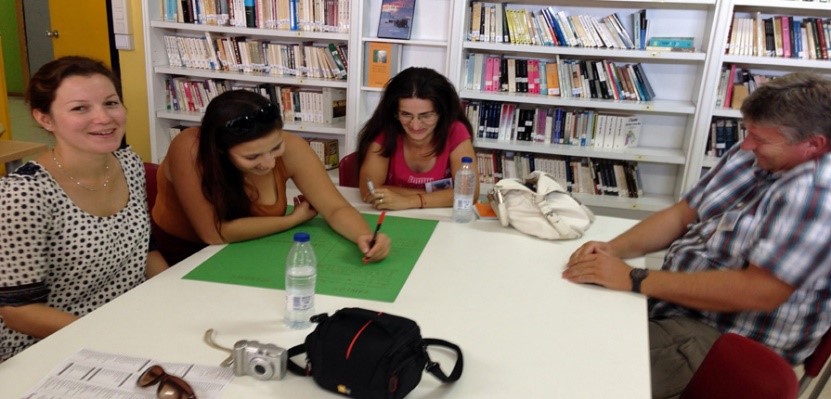Teaching Method: Action orientation
Action-oriented teaching in IT is a holistic, student-active teaching in which the action products agreed between the teacher and the students determine the organization of the teaching process. The aim is to balance the “head, heart and hand”, i.e. cognitive, affective and psychomotor learning of the students. It is not a didactic model, but merely a didactic-methodical concept.
- 1st Possibility: The action-oriented instruction in IT for adults usually starts from a concrete situation to the exercise (first step), to derive from it (second step) a general law or to explain a general principle (inductive approach).
- 2nd possibility: The action-oriented instruction in IT for adults could also be instructional learning. The teacher first explains the principle (such as being drawn), the lawfulness or the context, and then deals with individual cases in the form of exercises or examples (deductive approach).
Both methods of action orientation are used alternately in the course described above.
At the end of the course, the adult learners say: Not only do we know how something works, we can do it ourselves because we had action-oriented lessons.
Teaching Method: Discovering learning
Exploratory Learning (also known as Explorative Learning) is a method of acquiring knowledge as well as physical and technical skills. The focus of the consideration lies with the student and not with the mediation by the teacher. Its origin in recent times, the discoverer had learning in the lively teaching suggestions, which were also developed for younger ages.
Learning Discovery focuses on learning stimuli or learning arrangements that motivate self-active learning. Regularly reviewing existing knowledge and, if necessary, replacing it with current information is crucial for survival in today’s knowledge society.
Example:
The computer is the ideal tool for “discovery learning” because it immediately gives feedback on whether the activity was successful or not. A simple example is the marking of text to make it “bold”. One lets the students try on a finished text, how to mark and with which commands one can change the text. This will be quick and successful through discovery learning so that at the end of the lesson, the principle of changing the text attributes with the students has been worked out together. The student can always apply this principle later because it works the same way in virtually every program.
This method is possible for both children and adolescents, as well as for adults. This method works especially well for adults who have little or no prior knowledge.
This method is also good for learning ICT, because the computer responds immediately through the screen and indicates whether the command was successful or not.
Methodology: Cooperative learning

Cooperative learning refers to learning arrangements such as partner and group work that require a synchronous or asynchronous (via computer), coordinated, co-constructive activity of participants to develop a common solution to a problem or a shared understanding of a situation.
Cooperative learning is especially recommended for adults who already have previous professional knowledge and want to enter the job market, because co-operation in learning also means learning about cooperation in working.
The following peculiarities must be considered in cooperative learning:
- Central to cooperative learning is that everyone is responsible for learning the group as well as their own.
- Cooperative learning has two levels of responsibility: firstly, the responsibility of the entire group to achieve the group goals, and secondly, the responsibility of each group member to do their share of the work.
- Both levels of responsibility must be integrated into cooperative teaching. This is achieved by measuring and reporting the performance of each member and giving the rewards at the team level. Studies show, however, that group affiliation and interpersonal interaction between students only produce higher levels of achievement when the positive dependency is clearly structured
Method of social inclusion: Learning by cooperative doing

Learning by doing is the most common form of learning in the lifelong learning process alongside learning by the model. Especially older people, who have a lot of life experience but have not learned new models and techniques, can eradicate existing deficits by learning by doing in the community.
The above-described project of Volkshochschule München has two objectives:
- Older people learn new techniques to handle money. For this they must also learn the basics of computer technology.
- Since these seniors do not learn alone, they can share in the group and open new relationships. This is a great way to integrate older people.
- Elderly people become more secure when dealing with computers, allowing them to manage their lives without help.
The UNCEC United Nations Economic Commission for Europe rightly describes what efforts are needed to integrate the elderly. Here are some excerpts:
The challenge
People live longer and healthier than ever before and have the potential to make important contributions to society, even in their old age. However, older people are often threatened by exclusion, marginalization and discrimination.
Recommended strategies
• Strengthening older people’s skills in policy
• Promoting the participation of older people in the labour market
• Promoting lifelong learning and education for the elderly, especially in new techniques and in new media
• Recognition of older people as a consumer group with specific needs, interests and preferences
• Considering the needs of older people in terms of housing, public transport and cultural activities
• Promote intergenerational relationships through positive media coverage and public image campaigns
• Promoting civilian engagement of older people and strengthening the role of volunteering
Expected result
• Better quality of life for the elderly
• Increased social cohesion in society as a whole
• Achieving a society for all ages
Teaching Method: Holism
Holisticness in pedagogy refers to an integrative component of action-oriented concepts. Initial approaches are already to be found with the idea of elementary education, learning with the head, heart and hand. Based on reform pedagogy, holistic learning emphasizes not only the traditionally privileged cognitive-intellectual aspects but also physical and emotional-emotional aspects: holistic learning is learning with all senses, learning with intellect, mind and body.
This methodical approach considers the following example: PC Learning Café
In a casual atmosphere, the participants can sit down with a cup of coffee and a piece of cake at the PC and learn. Your questions will be answered by other participants or by a tutor. The special thing about these courses is that there is no compulsion and all learning achievements build on the previous knowledge.
Teaching-Method: Holism Learning
This methodical approach considers the following example: PC Learning Café
In a casual atmosphere, the participants can sit down with a cup of coffee and a piece of cake at the PC and learn. Your questions will be answered by other participants or by a tutor. The special thing about these courses is that there is no compulsion and all learning achievements build on the previous knowledge.
It is not to be underestimated, which advantages such a learning has:
- Learning is voluntary.
- Learning is fun.
- Learning is not the sole purpose of the gatherings.
- A meeting in a relaxed atmosphere helps with social integration.
- The learner determines his own pace of learning by asking questions on the subject that interests him.
- The learner determines the time and duration of the learning itself.













